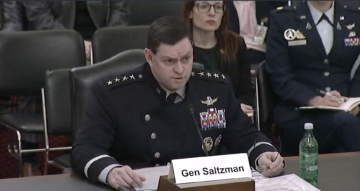
WASHINGTON — A Government Accountability Office report warns that NASA’s Artemis program faces technical risks as well as management issues that raise doubts about achieving the goal of returning humans to the moon by 2024.
The May 26 report by the GAO, requested by Congress in a 2018 appropriations bill, concluded that NASA’s approach to managing the various projects involved with the overall Artemis effort increased the odds of cost increases and schedule slips.
“With just over 3 years remaining, NASA lacks insight into the cost and schedules of some of its largest lunar programs in part because some of its programs are in the early stage of development and therefore have not yet established cost and schedule estimates or baselines,” the GAO stated in its report.
One factor in that lack of estimates and baselines is the use of service contracts, like the Human Landing System (HLS) program, where NASA will procure landing services from companies rather than the landers themselves. NASA argues that approach enables flexibility and innovation, the GAO noted.
However, it added that such an approach “may again result in NASA delaying the establishment of higher-level agency requirements as it obtains input from industry.” Those delays can have cost and schedule impacts. “The later the trade-offs occur, the more expensive they become to address.” It added that NASA has yet to provide a cost estimate of the Artemis 3 lunar landing mission, a recommendation the GAO made in late 2019.
Another management issue is that NASA does not consider Artemis a formal program and thus subject to agency program management rules, including documenting management practices and tools. “Given that NASA has chosen not to designate Artemis as a formal program, which would follow NASA’s program management policy, the agency lacks a finalized roadmap for how it plans to manage the effort,” the GAO stated.
The GAO report also raised questions about NASA’s management of technical risk. NASA expected that companies bidding on the HLS program would offer “mature technologies” for their lunar lander concepts in order meet the 2024 landing goal.
Companies, though, offered designs that used technologies still in development. “Our analysis of HLS critical technologies data for all three contractors showed that the contractors proposed only four mature technologies out of a total of 11 critical technologies at the time of the base contract award,” the report concluded.
NASA’s decision to launch the first elements of the lunar Gateway, the Power and Propulsion Element (PPE) and Habitation and Logistics Outpost (HALO), together has created technical complications. Launching the two together, rather than individually, was intended to save on launch costs and reduce the risks involved with an autonomous docking in cislunar space.
However, the combined mass of the two modules, along with the elimination of a separate propulsion unit for HALO, requires the PPE to use a more advanced solar electric propulsion system to generate sufficient thrust to transport the modules to lunar orbit. That system is still in development, and using a lower-power system is not a viable backup option.
The GAO report made four recommendations for the management of the Artemis program. NASA rejected one of them regarding cost estimates for the VIPER robotic rover mission, where the GAO recommended NASA include both launch costs and work on a precursor project, Resource Prospector. It did accept the other three, regarding risk mitigation for service contracts, assessment of the Gateway program’s risks and schedule, and documenting the program management processes for the Artemis program.
The report did not take a formal stand on the ability of NASA to achieve the 2024 goal, but some in Congress saw the report as evidence that NASA needs to revisit the overall Artemis effort.
“The GAO report released today should serve as a clear wake-up call both to NASA’s leadership and to members of Congress that NASA’s Artemis Moon-Mars initiative is in serious trouble, and strong corrective actions will be needed if it is to succeed,” Rep. Eddie Bernice Johnson (D-Texas), chair of the House Science Committee, said in a statement. She called on NASA Administrator Bill Nelson to perform an independent review of Artemis “so that he can determine what will be needed to put this important national undertaking on an executable path.”
“Today’s GAO report raises questions about NASA’s current approach to managing Artemis,” said Rep. Don Beyer (D-Va.), chair of the committee’s space subcommittee, in the same statement. “A national endeavor as critical as Artemis requires clear roles and responsibilities, defined management tools, cost and schedule oversight, and an organization focused on mission success. GAO’s report identifies the need for improvement in these areas in order to avoid further delays and costs, and to ensure a successful outcome.”
The GAO’s concerns clashed with more optimistic assessments offered by NASA officials. At a May 25 meeting of the National Academies’ Aeronautics and Space Engineering Board and Space Studies Board, Kathy Lueders, NASA associate administrator for human exploration and operations, said preparations for the Artemis 1 launch were running slightly ahead of schedule, keeping alive the changes of a launch before the end of the year.
However, she said that NASA was still finalizing a fixed-price contract with Northrop Grumman for the HALO module. That contract would require delivery of the module at the end of 2024, with launch by early 2025.
The agency was also working on long-term management of Artemis that fits into projected budgets. “You have to have the long view for these missions. We’ve got to lay them in, do them the right steps at a time and making sure they fit within their budget profile,” she said.
Earlier in the day at the same meeting, Nelson said he still hoped the Artemis 3 mission could launch in 2024. “It’s a very aggressive agenda,” he said of that schedule.
Source: https://spacenews.com/gao-report-identifies-technical-and-management-risks-with-artemis/
- 11
- 2019
- Aeronautics
- All
- analysis
- Artemis program
- autonomous
- Backup
- Bill
- board
- call
- Companies
- Congress
- contract
- contracts
- Costs
- Current
- data
- day
- delays
- delivery
- Development
- DID
- Early
- early stage
- Electric
- Engineering
- estimates
- exploration
- faces
- First
- fit
- Flexibility
- follow
- GAO
- Government
- House
- How
- HTTPS
- Humans
- Including
- industry
- Initiative
- Innovation
- involved
- issues
- IT
- Johnson
- keeping
- launch
- Leadership
- logistics
- Long
- Lunar
- lunar lander
- Making
- management
- Members
- Mission
- Moon
- Nasa
- offer
- Operations
- Option
- order
- Other
- policy
- power
- PPE
- Profile
- Program
- Programs
- project
- projects
- raise
- raises
- reduce
- report
- Requirements
- resource
- review
- Risk
- Risk Mitigation
- rover
- rules
- running
- Science
- Services
- solar
- Space
- Stage
- Statement
- studies
- success
- successful
- system
- Technical
- Technologies
- time
- transport
- View
- within
- Work
- year
- years








